
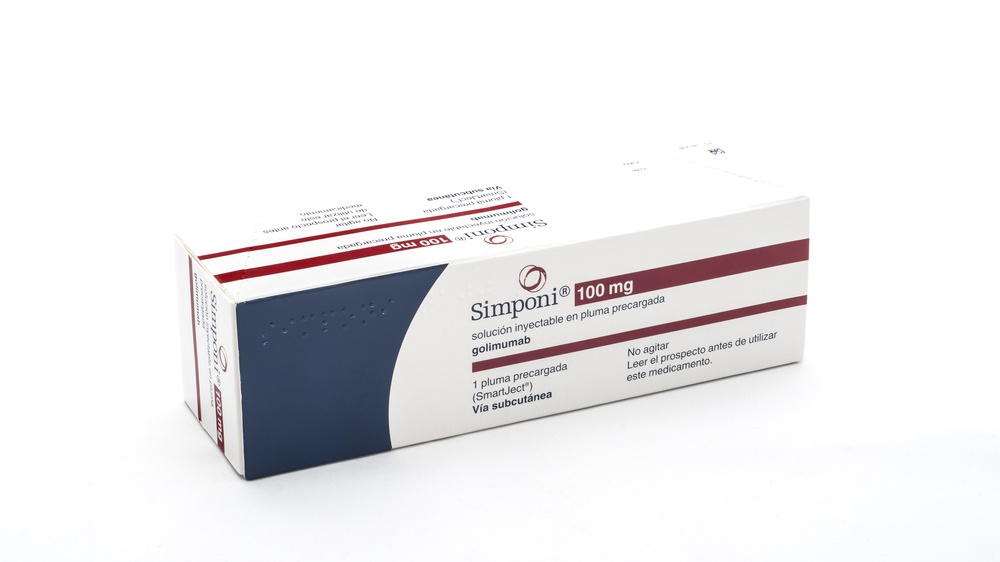
СИМПОНИ 100 мг РАСТВОР ДЛЯ ИНЪЕКЦИЙ В ПРЕДНАПОЛНЕННОМ ШПРИЦЕ-РУЧКЕ


Инструкция по применению СИМПОНИ 100 мг РАСТВОР ДЛЯ ИНЪЕКЦИЙ В ПРЕДНАПОЛНЕННОМ ШПРИЦЕ-РУЧКЕ
Введение
Прошу прочитать: информация для пользователя
Симпони 100мг раствор для инъекций в предварительно заполненном шприце
голимумаб
Прочитайте внимательно весь листок-вкладыш перед началом использования этого лекарственного средства, поскольку он содержит важную информацию для вас.
- Сохраните этот листок-вкладыш, поскольку вам, возможно, придется перечитать его.
- Если у вас есть какие-либо вопросы, проконсультируйтесь с вашим врачом, фармацевтом или медсестрой.
- Это лекарственное средство было назначено только вам, и не передавайте его другим людям, даже если у них такие же симптомы, как у вас, поскольку оно может нанести им вред.
- Если вы испытываете побочные эффекты, проконсультируйтесь с вашим врачом, фармацевтом или медсестрой, даже если это побочные эффекты, которые не указаны в этом листке-вкладыше. См. раздел 4.
Кроме того, ваш врач предоставит вам Карточку информации для пациента, содержащую важную информацию о безопасности, которую вам необходимо знать до и во время лечения Симпони.
Содержание листка-вкладыша
- Что такое Симпони и для чего он используется
- Что вам необходимо знать до начала использования Симпони
- Как использовать Симпони
- Возможные побочные эффекты
- Хранение Симпони
- Содержание упаковки и дополнительная информация
1. Что такое Симпони и для чего он используется
Симпони содержит активное вещество под названием голимумаб.
Симпони относится к группе лекарственных средств, называемых «блокаторы TNF». Он используется у взрослыхдля лечения следующих воспалительных заболеваний:
- Ревматоидный артрит
- Псориатический артрит
- Аксиальный спондилоартрит, который включает анкилозирующий спондилоартрит и не радиологический аксиальный спондилоартрит
- Язвенный колит
Симпони действует путем блокирования действия белка, называемого «фактор некроза опухоли альфа» (TNF-α). Этот белок участвует в воспалительных процессах организма, и его блокирование может уменьшить воспаление в вашем теле.
Ревматоидный артрит
Ревматоидный артрит - это воспалительное заболевание суставов. Если у вас активный ревматоидный артрит, вам сначала будут назначены другие лекарства. Если вы не реагируете должным образом на эти лекарства, вам может быть назначен Симпони в комбинации с другим лекарством под названием метотрексат для:
- Уменьшения симптомов и признаков вашего заболевания.
- Замедления повреждения костей и суставов.
- Улучшения вашего физического состояния.
Псориатический артрит
Псориатический артрит - это воспалительное заболевание суставов, обычно сопровождающееся псориазом, воспалительным заболеванием кожи. Если у вас активный псориатический артрит, вам сначала будут назначены другие лекарства. Если вы не реагируете должным образом на эти лекарства, вам может быть назначен Симпони для:
- Уменьшения симптомов и признаков вашего заболевания.
- Замедления повреждения костей и суставов.
- Улучшения вашего физического состояния.
Анкилозирующий спондилоартрит и не радиологический аксиальный спондилоартрит
Анкилозирующий спондилоартрит и не радиологический аксиальный спондилоартрит - это воспалительные заболевания позвоночника. Если у вас анкилозирующий спондилоартрит или не радиологический аксиальный спондилоартрит, вам сначала будут назначены другие лекарства. Если вы не реагируете должным образом на эти лекарства, вам может быть назначен Симпони для:
- Уменьшения симптомов и признаков вашего заболевания
- Улучшения вашего физического состояния.
Язвенный колит
Язвенный колит - это воспалительное заболевание кишечника. Если у вас язвенный колит, вам сначала будут назначены другие лекарства. Если вы не реагируете должным образом на эти лекарства, вам будет назначен Симпони для лечения вашего заболевания.
2. Что вам необходимо знать до начала использования Симпони
Не используйте Симпони
- Если вы аллергичны (гиперчувствительны) к голимумабу или к любому другому компоненту этого лекарственного средства (перечисленному в разделе 6).
- Если у вас туберкулез (ТБ) или любая другая тяжелая инфекция.
- Если у вас умеренная или тяжелая сердечная недостаточность.
Если вы не уверены, касается ли вас что-либо из вышеизложенного, проконсультируйтесь с вашим врачом, фармацевтом или медсестрой перед использованием Симпони.
Предостережения и меры предосторожности
Проконсультируйтесь с вашим врачом, фармацевтом или медсестрой перед началом использования Симпони.
Инфекции
Сообщите вашему врачу немедленно, если у вас уже есть или появляются какие-либо симптомы инфекции во время или после лечения Симпони. Среди симптомов инфекции - лихорадка, кашель, затруднение дыхания, симптомы гриппа, диарея, раны, проблемы с зубами или ощущение жжения при мочеиспускании.
- Во время использования Симпони вы можете легче подвергаться инфекциям.
- Инфекции могут прогрессировать быстрее и могут быть более тяжелыми. Кроме того, могут возобновиться некоторые предыдущие инфекции.
Туберкулез (ТБ)
Сообщите вашему врачу немедленно, если появляются симптомы ТБ во время или после лечения. Среди симптомов ТБ - постоянный кашель, потеря веса, усталость, лихорадка или ночная потливость.
- Были зарегистрированы случаи туберкулеза у пациентов, леченных Симпони, и в редких случаях даже у пациентов, которые были лечены лекарствами от ТБ. Ваш врач проведет тесты, чтобы проверить, есть ли у вас ТБ. Ваш врач запишет эти тесты в вашу Карточку информации для пациента.
- Очень важно, чтобы вы сообщили вашему врачу, если у вас когда-либо был ТБ или если у вас был близкий контакт с кем-то, кто имел или имеет ТБ.
- Если ваш врач считает, что вы находитесь в группе риска заражения ТБ, он может назначить вам лекарства от ТБ до начала лечения Симпони.
Вирус гепатита Б (ВГБ)
- Сообщите вашему врачу, если вы носитель или если у вас был или есть гепатит Б до того, как вам будет назначен Симпони
- Сообщите вашему врачу, если вы считаете, что можете быть подвержены риску заражения ВГБ
- Ваш врач должен провести тесты на ВГБ
- Лечение блокаторами TNF, такими как Симпони, может привести к реактивации вируса гепатита Б у носителей этого вируса, что в некоторых случаях может быть потенциально смертельным.
Инвазивные грибковые инфекции
Вы должны сообщить вашему врачу немедленно, если вы жили или путешествовали в место, где часто встречаются инфекции, вызванные определенными типами грибов, которые могут поражать легкие или другие части вашего организма (называемые гистоплазмозом, кокцидиоидомикозом или бластомикозом). Если вы не знаете, являются ли эти инфекции часто встречающимися в месте, где вы жили или путешествовали, проконсультируйтесь с вашим врачом.
Рак и лимфома
Сообщите вашему врачу, если вам когда-либо был диагностирован лимфома (тип рака крови) или любой другой рак до использования Симпони.
- Если вы используете Симпони или другой блокатор TNF, риск развития лимфомы или другого рака может быть увеличен.
- Пациенты с тяжелым ревматоидным артритом и другими воспалительными заболеваниями, которые имели болезнь в течение долгого времени, могут иметь более высокий риск развития лимфомы.
- У детей и подростков, леченных блокаторами TNF, были зарегистрированы случаи рака, некоторые из которых были редкими, и в некоторых случаях dẫnели к смерти.
- В редких случаях был обнаружен тяжелый и специфический тип лимфомы, называемый гепатоспленическим лимфомой Т-клеток, у пациентов, принимающих другие блокаторы TNF. Большинство этих пациентов были молодыми мужчинами или взрослыми. Этот тип рака обычно смертелен. Почти все эти пациенты также принимали лекарства, такие как азатиоприн или 6-меркаптопурин. Сообщите вашему врачу, если вы принимаете азатиоприн или 6-меркаптопурин с Симпони.
- Пациенты с тяжелым персистирующим бронхитом, хронической обструктивной болезнью легких (ХОБЛ) или тяжелыми курильщиками могут иметь более высокий риск развития рака при лечении Симпони. Если у вас тяжелый персистирующий бронхит, ХОБЛ или вы являетесь тяжелым курильщиком, проконсультируйтесь с вашим врачом, является ли лечение блокатором TNF подходящим для вас.
- Некоторые пациенты, леченные голимумабом, развили некоторые виды рака кожи. Сообщите вашему врачу, если появляются изменения внешнего вида кожи или аномальный рост кожи во время или после лечения.
Сердечная недостаточность
Сообщите вашему врачу немедленно, если вы развили новые симптомы сердечной недостаточности или если симптомы, которые у вас уже есть, ухудшились. Среди симптомов сердечной недостаточности - затруднение дыхания или отек ног.
- Во время лечения блокаторами TNF, включая Симпони, было зарегистрировано появление или ухудшение сердечной недостаточности. Некоторые из этих пациентов умерли.
- Если у вас легкая сердечная недостаточность и вы лечитесь Симпони, ваш врач должен внимательно следить за вашим состоянием.
Заболевания нервной системы
Сообщите вашему врачу немедленно, если вам когда-либо был диагностирован или если вы развили симптомы демиелинизирующего заболевания, такого как рассеянный склероз. Симптомы могут включать изменения в вашем зрении, слабость рук или ног, или онемение или покалывание любой части вашего тела. Ваш врач решит, должны ли вы получать Симпони.
Операции или стоматологические процедуры
- Сообщите вашему врачу, если вы собираетесь пройти любую операцию или стоматологическую процедуру.
- Сообщите хирургу или стоматологу, который будет выполнять процедуру, что вы лечитесь Симпони, показав ему вашу Карточку информации для пациента.
Аутоиммунные заболевания
Сообщите вашему врачу, если вы развили симптомы заболевания, называемого системной красной волчанкой. Симптомы включают постоянную кожную сыпь, лихорадку, боль в суставах и усталость.
- В редких случаях пациенты, леченные блокаторами TNF, развили системную красную волчанку.
Заболевания крови
У некоторых пациентов организм может перестать производить достаточно клеток крови, которые помогают вашему телу бороться с инфекциями или останавливать кровотечение. Если вы развили постоянную лихорадку, синяки или кровотечение очень легко или если у вас бледная кожа, сообщите вашему врачу немедленно. Ваш врач может решить прекратить лечение.
Если вы не уверены, касается ли вас что-либо из вышеизложенного, проконсультируйтесь с вашим врачом или фармацевтом перед использованием Симпони.
Вакцины
Сообщите вашему врачу, если вы были вакцинированы или собираетесь быть вакцинированными.
- Не следует вакцинироваться некоторыми вакцинами (живыми) во время лечения Симпони.
- Некоторые вакцины могут вызвать инфекции. Если вы были лечены Симпони во время беременности, ваш ребенок может иметь более высокий риск заражения этими инфекциями до примерно шести месяцев после последней дозы, полученной во время беременности. Важно, чтобы вы сообщили врачам вашего ребенка и другим медицинским работникам о вашем лечении Симпони, чтобы они могли решить, когда вашему ребенку следует быть вакцинированным.
Терапевтические инфекционные агенты
Сообщите вашему врачу, если вы недавно получили или собираетесь получить лечение терапевтическими инфекционными агентами (например, инстилляцией БЦЖ, используемой для лечения рака).
Аллергические реакции
Сообщите вашему врачу немедленно, если вы развили симптомы аллергической реакции после лечения Симпони. Симптомы аллергической реакции могут быть отеком лица, губ, рта или горла, который может вызвать затруднение глотания или дыхания, кожной сыпью, уртикарией, отеком рук, ног или стоп.
- Некоторые из этих реакций могут быть тяжелыми или, в редких случаях, потенциально смертельными.
- Некоторые из этих реакций произошли после первой инъекции Симпони.
Дети и подростки
Симпони 100 мг не рекомендуется для детей и подростков (младше 18 лет).
Другие лекарственные средства и Симпони
- Сообщите вашему врачу или фармацевту, если вы используете, недавно использовали или можете использовать любое другое лекарственное средство, включая другие лекарства для лечения ревматоидного артрита, псориатического артрита, анкилозирующего спондилоартрита, не радиологического аксиального спондилоартрита или язвенного колита.
- Не используйте Симпони с лекарствами, содержащими активное вещество анакинра или абатацепт. Эти лекарства используются для лечения ревматических заболеваний.
- Сообщите вашему врачу или фармацевту, если вы используете любое другое лекарство, которое влияет на вашу иммунную систему.
- Не следует получать некоторые вакцины (живые) во время лечения Симпони.
Если вы не уверены, используете ли вы какие-либо из вышеуказанных лекарств, проконсультируйтесь с вашим врачом или фармацевтом перед использованием Симпони.
Беременность и лактация
Проконсультируйтесь с вашим врачом перед использованием Симпони, если:
- Вы беременны или планируете стать беременной во время лечения Симпони. Есть ограниченная информация о влиянии этого лекарства на беременных женщин. Если вы лечитесь Симпони, вы должны избегать беременности с помощью подходящих методов контрацепции во время лечения и в течение как минимум 6 месяцев после последней инъекции Симпони. Вы должны использовать Симпони во время беременности только в случае крайней необходимости для вас.
- Прежде чем начать кормить грудью, должно пройти как минимум 6 месяцев после последнего лечения Симпони. Вы должны прекратить кормить грудью, если вам будет назначен Симпони.
- Если вы были лечены Симпони во время беременности, ваш ребенок может иметь более высокий риск заражения инфекцией. Важно, чтобы вы сообщили врачам вашего ребенка и другим медицинским работникам о вашем лечении Симпони до того, как ваш ребенок будет вакцинирован (для более подробной информации см. раздел о вакцинах).
Если вы беременны, кормите грудью, считаете, что можете быть беременной или планируете стать беременной, проконсультируйтесь с вашим врачом или фармацевтом перед использованием этого лекарственного средства.
Вождение и использование машин
Симпони имеет незначительное влияние на вашу способность управлять транспортными средствами и использовать инструменты или машины. Однако может появиться головокружение после инъекции Симпони. Если это произойдет, не управляйте транспортными средствами и не используйте никакие инструменты или машины.
Симпони содержит латекс и сорбитол
Чувствительность к латексу
Часть предварительно заполненного шприца, крышка иглы, содержит латекс. Поскольку латекс может вызвать тяжелые аллергические реакции, проконсультируйтесь с вашим врачом перед использованием Симпони, если вы или ваш опекун аллергичны к латексу.
Непереносимость сорбитола
Это лекарственное средство содержит 41 мг сорбитола (Е-420) в каждом предварительно заполненном шприце.
3. Как использовать Симпони
Следуйте точно инструкциям по применению этого лекарственного средства, указанным вашим врачом или фармацевтом. В случае сомнений проконсультируйтесь с вашим врачом или фармацевтом.
Какая доза Симпони используется
Ревматоидный артрит, псориатический артрит и спондилоартрит, который включает анкилозирующий спондилоартрит и не радиологический спондилоартрит:
- Рекомендуемая доза составляет 50 мг, вводимая один раз в месяц, в один и тот же день каждого месяца.
- Проконсультируйтесь с вашим врачом перед тем, как будет введена четвертая доза. Ваш врач определит, следует ли продолжать лечение Симпони.
- Если ваш вес превышает 100 кг, дозу можно увеличить до 100 мг (содержимое 1 предварительно заполненного шприца), вводимого один раз в месяц, в один и тот же день каждого месяца.
Язвенный колит
- Следующая таблица показывает, как вы обычно будете использовать это лекарственное средство.
Первоначальное лечение | Первоначальная доза 200 мг (содержимое 2 предварительно заполненных шприцев) за которой следует 100 мг (содержимое 1 предварительно заполненного шприца) через 2 недели. |
Поддерживающее лечение |
|
Как вводится Симпони
- Симпони вводится путем подкожной инъекции.
- Сначала ваш врач или медсестра могут вводить Симпони. Однако вы и ваш врач можете решить, что вы можете самостоятельно вводить Симпони. В этом случае вам будет показано, как вводить Симпони самостоятельно.
Проконсультируйтесь с вашим врачом, если у вас есть какие-либо вопросы о том, как вводить инъекцию. В конце этого листка-вкладыша вы найдете подробные «Инструкции по применению».
Если вы использовали больше Симпони, чем должны
Если вы использовали или вам было введено слишком много Симпони (введено слишком много за одну раз или использовано слишком часто), проконсультируйтесь с вашим врачом или фармацевтом немедленно. Всегда носите с собой внешнюю упаковку, даже если она пуста, и этот листок-вкладыш.
Если вы пропустили использованиеСимпони
Если вы пропустили использование Симпони в запланированную дату, введите пропущенную дозу как можно скорее.
Не вводите двойную дозу, чтобы компенсировать пропущенные дозы.
Когда вводить следующую дозу:
- Если доза задерживается менее чем на 2 недели, введите пропущенную дозу как можно скорее и сохраните ваш исходный график.
- Если доза задерживается более чем на 2 недели, введите пропущенную дозу как можно скорее и проконсультируйтесь с вашим врачом или фармацевтом, когда следует вводить следующую дозу.
Если вы не знаете, что делать, проконсультируйтесь с вашим врачом или фармацевтом.
Если вы прекратите лечение Симпони
Если вы думаете прекратить лечение Симпони, проконсультируйтесь с вашим врачом или фармацевтом.
Если у вас есть какие-либо другие вопросы о использовании этого лекарственного средства, спросите вашего врача, фармацевта или медсестру.
4. Возможные побочные эффекты
Как и все лекарства, это лекарство может вызывать побочные эффекты, хотя не все люди испытывают их. Некоторые пациенты могут испытывать серьезные побочные эффекты и могут потребовать лечения. Риск определенных побочных эффектов выше при дозе 100 мг по сравнению с дозой 50 мг. Побочные эффекты могут появляться до нескольких месяцев после последней инъекции.
Немедленно сообщите своему врачу, если вы заметите любой из серьезных побочных эффектов Симпони, которые включают:
- аллергические реакции, которые могут быть тяжелыми или, в редких случаях, потенциально смертельными (редко).Симптомы аллергической реакции могут включать отек лица, губ, рта или горла, который может вызывать трудности с глотанием или дыханием, кожную сыпь, крапивницу, отек рук, ног или лодыжек. Некоторые из этих реакций произошли после первой администрации Симпони.
- тяжелые инфекции (включая туберкулез, бактериальные инфекции, включая тяжелые инфекции крови и пневмонию, тяжелые грибковые инфекции и другие оппортунистические инфекции) (часто).Симптомы инфекции могут включать лихорадку, усталость, кашель (постоянный), трудности с дыханием, симптомы, похожие на грипп, потерю веса, ночную потливость, диарею, раны, проблемы с зубами и ощущение жжения при мочеиспускании.
- реактивация вируса гепатита Б, если вы являетесь носителем или ранее имели гепатит Б (редко).Симптомы, которые могут включать желтые глаза и кожу, темно-коричневую мочу, боль в правом боку живота, лихорадку, головокружение, рвоту и сильную усталость.
- заболевания нервной системы, такие как рассеянный склероз (редко).Симптомы заболевания нервной системы могут включать нарушения зрения, слабость в руках или ногах, онемение или покалывание любой части тела.
- рак лимфатических узлов (лимфома) (редко).Симптомы лимфомы могут включать отек лимфатических узлов, потерю веса или лихорадку.
- сердечная недостаточность (редко).Симптомы сердечной недостаточности могут включать трудности с дыханием или отек ног.
- признаки расстройств иммунной системы, называемых:
- системная красная волчанка (редко).Симптомы, которые могут включать боль в суставах или кожную сыпь на щеках или руках, чувствительную к солнцу.
- саркоидоз (редко).Симптомы могут включать постоянный кашель, одышку, боль в груди, лихорадку, отек лимфатических узлов, потерю веса, кожные сыпи и размытое зрение.
- отек небольших кровеносных сосудов (васкулит) (редко).Симптомы могут включать лихорадку, головную боль, потерю веса, ночную потливость, кожную сыпь и проблемы с нервами, такие как онемение и покалывание.
- рак кожи (не часто).Симптомы рака кожи могут включать изменения внешнего вида кожи или аномальный рост кожи.
- заболевания крови (часто).Симптомы заболевания крови могут включать постоянную лихорадку, синяки или легкое кровотечение или бледность.
- рак крови (лейкоз) (редко).Симптомы лейкоза могут включать лихорадку, усталость, частые инфекции, легкое кровотечение и ночную потливость.
Немедленно сообщите своему врачу, если вы заметите любой из вышеуказанных симптомов.
Были обнаружены следующие дополнительные побочные эффекты Симпони:
Очень частые побочные эффекты (могут поражать более 1 из 10 пациентов):
- Инфекции верхних дыхательных путей, боль в горле или хрипота, насморк
Частые побочные эффекты (могут поражать до 1 из 10 пациентов):
- Нарушения функции печени (повышение печеночных ферментов) при анализе крови, назначенном вашим врачом
- Головокружение
- Головная боль
- Онемение или покалывание
- Поверхностные грибковые инфекции
- Абсцессы
- Бактериальные инфекции (такие как целлюлит)
- Низкий уровень красных кровяных телец
- Низкий уровень белых кровяных телец
- Положительный тест на системную красную волчанку в крови
- Аллергические реакции
- Изжога
- Боль в животе
- Тошнота
- Грипп
- Бронхит
- Синусит
- Герпес
- Высокое кровяное давление
- Лихорадка
- Астма, одышка, трудности с дыханием
- Расстройства желудка и кишечника, включая воспаление внутреннего слоя желудка и толстой кишки, которые могут вызывать лихорадку
- Боль и язвы во рту
- Реакции в месте инъекции (включая покраснение, уплотнение, боль, синяки, зуд, покалывание и раздражение)
- Потеря волос
- Кожная сыпь и зуд
- Трудности со сном
- Депрессия
- Слабость
- Переломы костей
- Боль в груди
Не часто встречающиеся побочные эффекты (могут поражать до 1 из 100 пациентов):
- Инфекция почки
- Рак, такой как рак кожи и доброкачественные опухоли, включая родинки
- Пузырьки на коже
- Тяжелая инфекция всего тела (сепсис), которая иногда включает низкое кровяное давление (септический шок)
- Псориаз (включая на ладонях и/или подошвах и/или пузырчатый тип)
- Низкий уровень тромбоцитов
- Низкий уровень тромбоцитов, красных и белых кровяных телец
- Расстройства щитовидной железы
- Повышение уровня сахара в крови
- Повышение уровня холестерина в крови
- Расстройства равновесия
- Нарушения зрения
- Воспаление глаза (конъюнктивит)
- Аллергия глаза
- Ощущение нерегулярного сердцебиения
- Сужение кровеносных сосудов сердца
- Тромбы
- Рубор
- Запор
- Хроническое воспалительное заболевание легких
- Рефлюкс
- Желчные камни
- Расстройства печени
- Расстройства молочной железы
- Расстройства менструального цикла
Редкие побочные эффекты (могут поражать до 1 из 1000 пациентов):
- Недостаточная функция костного мозга для производства кровяных клеток
- Тяжелое снижение количества белых кровяных телец в крови
- Инфекция суставов или окружающих тканей
- Проблемы с заживлением
- Воспаление кровеносных сосудов в внутренних органах
- Лейкоз
- Меланома (тип рака кожи)
- Рак Меркеля (тип рака кожи)
- Лихеноидные реакции (зудящая красно-фиолетовая кожная сыпь и/или толстые бело-серые линии на слизистых)
- Отслоение и шелушение кожи
- Расстройства иммунной системы, которые могут поражать легкие, кожу и лимфатические узлы (обычно проявляется как саркоидоз).
- Боль и изменение цвета пальцев рук или ног
- Нарушения вкуса
- Расстройства мочевого пузыря
- Расстройства почки
- Воспаление кровеносных сосудов в коже, вызывающее сыпь
Побочные эффекты с неизвестной частотой:
- Редкий тип рака крови, поражающий в основном молодых людей (гепатоспленический Т-клеточный лимфома)
- Саркома Капоши, редкий тип рака, связанный с вирусом человеческого герпеса 8. Саркома Капоши обычно проявляется как кожные поражения фиолетового цвета
- Ухудшение заболевания, называемого дерматомиозитом (которое проявляется как кожная сыпь, сопровождающаяся мышечной слабостью)
Сообщение о побочных эффектах
Если вы испытываете любой побочный эффект, проконсультируйтесь с вашим врачом, фармацевтом или медсестрой, даже если это возможные побочные эффекты, которые не указаны в этом описании. Вы также можете сообщить об этом напрямую через национальную систему уведомления, указанную в Приложении V. Сообщая о побочных эффектах, вы можете внести свой вклад в предоставление более полной информации о безопасности этого лекарства.
5. Хранение Симпони
- Храните это лекарство в недоступном для детей месте.
- Не используйте это лекарство после даты истечения срока годности, указанной на этикетке и упаковке после "СГ". Дата истечения срока годности - последний день месяца, указанного.
- Храните в холодильнике (при температуре от 2°C до 8°C). Не замораживайте.
- Храните предварительно заполненную ручку в наружной упаковке, чтобы защитить ее от света.
- Это лекарство также можно хранить вне холодильника при температуре до 25°C в течение одного периода до 30 дней, но не более первоначальной даты истечения срока годности, напечатанной на коробке. Запишите новую дату истечения срока годности на коробке, включая день/месяц/год (не более 30 дней после того, как лекарство было удалено из холодильника). Если лекарство достигло комнатной температуры, не возвращайте его в холодильник. Утилизируйте это лекарство, если оно не было использовано до новой даты истечения срока годности или даты истечения срока годности, указанной на коробке, что происходит раньше.
- Не используйте это лекарство, если вы заметите, что жидкость не прозрачна или имеет светло-желтый цвет, мутна или содержит посторонние частицы.
- Лекарства не должны выбрасываться в канализацию или мусор. Спросите вашего врача или фармацевта, как утилизировать упаковку и лекарства, которые вам больше не нужны. Таким образом, вы поможете защитить окружающую среду.
6. Содержимое упаковки и дополнительная информация
СоставСимпони
Активное вещество - голимумаб. Предварительно заполненный инжектор объемом 1 мл содержит 100 мг голимумаба.
Другие компоненты - сорбитол (Е-420), гистидин, моногидрат гидрохлорида гистидина, полисорбат 80 и вода для инъекционных препаратов. Для получения более подробной информации о сорбитоле (Е-420) см. раздел 2.
Внешний вид продукта и содержимое упаковки
Симпони выпускается в виде раствора для инъекций в предварительно заполненном инжекторе одноразового использования. Симпони доступен в упаковках, содержащих 1 предварительно заполненный инжектор, и в многодозовых упаковках, содержащих 3 предварительно заполненных инжектора (3 упаковки по 1). Возможно, что будут продаваться только некоторые размеры упаковок.
Раствор прозрачный или слегка опалесцирующий (с перламутровым блеском), бесцветный или светло-желтый, и может содержать небольшие прозрачные или белые частицы белка. Не используйте Симпони, если раствор изменил цвет, стал мутным или в нем появились посторонние частицы.
Владелец разрешения на маркетинг и ответственное лицо за производство
Janssen Biologics B.V.
Einsteinweg 101
2333 CB Лейден
Нидерланды
Вы можете получить дополнительную информацию о этом лекарственном средстве, обратившись к местному представителю владельца разрешения на маркетинг:
Бельгия/Белгique/Бельгиен MSD Belgium Тел.: +32(0)27766211 | Литва UAB Merck Sharp & Dohme Тел.: + 370 5 278 02 47 |
Болгария Мерк Шарп и Дом (Болгария) ЕООД Тел.: +359 2 819 3737 | Люксембург MSD Belgium Тел.: (+32(0)27766211) |
Чешская Республика Merck Sharp & Dohme, s.r.o. Тел.: +420 233 010 111 | Венгрия MSD Pharma Hungary Kft. Тел.: +36 1 888 5300 |
Дания MSD Danmark ApS Тел.: + 45 4482 4000 | Мальта Merck Sharp & Dohme Cyprus Limited Тел.: 8007 4433 (+356 99917558) |
Германия MSD Sharp & Dohme GmbH Тел.: 0800 673 673 673 (+49 (0) 89 4561 0) | Нидерланды Merck Sharp & Dohme B.V. Тел.: 0800 9999000 (+31 23 5153153) |
Эстония Merck Sharp & Dohme OÜ Тел.: +372 6144 200 | Норвегия MSD (Norge) AS Тел.: +47 32 20 73 00 |
Греция MSD Α.Φ.Β.Ε.Ε. Тел.: +30 210 98 97 300 | Австрия Merck Sharp & Dohme Ges.m.b.H. Тел.: +43 (0) 1 26 044 |
Испания Merck Sharp & Dohme de España, S.A. Тел.: +34 91 321 06 00 | Польша MSD Polska Sp. z o.o. Тел.: +48 22 549 51 00 |
Франция MSD France Тел.: + 33 (0) 1 80 46 40 40 | Португалия Merck Sharp & Dohme, Lda Тел.: +351 21 4465700 |
Хорватия Merck Sharp & Dohme d.o.o. Тел.: + 385 1 6611 333 | Румыния Merck Sharp & Dohme Romania S.R.L. Тел.: +40 21 529 29 00 |
Ирландия Merck Sharp & Dohme Ireland (Human Health) Limited Тел.: +353 (0)1 2998700 | Словения Merck Sharp & Dohme, inovativna zdravila d.o.o. Тел.: +386 1 5204 201 |
Исландия Vistor hf. Тел.: + 354 535 7000 | Словакия Merck Sharp & Dohme, s. r. o. Тел.: +421 2 58282010 |
Италия MSD Italia S.r.l. Тел.: 800 23 99 89 (+39 06 361911) | Финляндия MSD Finland Oy Тел.: +358 (0)9 804 650 |
Кипр Merck Sharp & Dohme Cyprus Limited Тел.: 800 00 673 (+357 22866700) | Швеция Merck Sharp & Dohme (Sweden) AB Тел.: +46 77 5700488 |
Латвия SIA Merck Sharp & Dohme Latvija Тел.: + 371 67364224 | Великобритания (Северная Ирландия) Merck Sharp & Dohme Ireland (Human Health) Limited Тел.: +35312998700 |
Дата последнего пересмотра этой инструкции:
Подробная информация о этом лекарственном средстве доступна на сайте Европейского агентства по лекарственным средствам: http://www.ema.europa.eu.
ИНСТРУКЦИИ ПО ПРИМЕНЕНИЮ
Если вы хотите вводить Симпони самостоятельно, необходимо, чтобы медицинский работник научил вас подготовке инъекции и введению ее. Если вам не научили, обратитесь к врачу, медсестре или фармацевту, чтобы назначить сеанс обучения.
В этих инструкциях:
- Подготовка к использованию предварительно заполненного инжектора
- Выбор и подготовка места инъекции
- Введение препарата
- После инъекции
Следующая иллюстрация (см. рисунок 1) показывает, как выглядит предварительно заполненный инжектор «SmartJect».

Рисунок 1
- Подготовка к использованию предварительно заполненного инжектора
- Не встряхивайте предварительно заполненный инжектор ни в коем случае.
- Не снимайте крышку с предварительно заполненного инжектора до момента инъекции.
- Не надевайте крышку обратно на предварительно заполненный инжектор, если она была снята, чтобы избежать повреждения иглы.
Проверьте количество предварительно заполненных инжекторов
Проверьте предварительно заполненные инжекторы, чтобы убедиться, что
- Количество предварительно заполненных инжекторов и доза правильные
- Если ваша доза составляет 100 мг, вы получите предварительно заполненный инжектор по 100 мг
- Если ваша доза составляет 200 мг, вы получите два предварительно заполненных инжектора по 100 мг и должны будете ввести себе две инъекции. Выберите разные места для этих инъекций и введите их одну за другой.
Проверьте дату истечения срока годности
- Проверьте дату истечения срока годности, напечатанную или написанную на упаковке.
- Проверьте дату истечения срока годности (указана как «СГ») на предварительно заполненном инжекторе.
- Не используйте предварительно заполненный инжектор, если дата истечения срока годности прошла. Дата истечения срока годности, указанная на упаковке, является последним днем месяца, указанного. Обратитесь к врачу или фармацевту.
Проверьте защитный чехол
- Проверьте защитный чехол вокруг крышки предварительно заполненного инжектора.
- Не используйте предварительно заполненный инжектор, если защитный чехол поврежден. Обратитесь к врачу или фармацевту.
Подождите 30 минут, чтобы предварительно заполненный инжектор достиг комнатной температуры
- Чтобы инъекция была правильной, оставьте предварительно заполненный инжектор при комнатной температуре вне упаковки в течение 30 минут, вне досягаемости детей.
- Не используйте другие методы для нагрева предварительно заполненного инжектора (например, не нагревайте его в микроволновой печи или горячей воде).
- Не снимайте крышку с предварительно заполненного инжектора, пока он достигает комнатной температуры.
Подготовьте остальной материал
- Пока вы ждете, подготовьте остальной материал, который вам понадобится, такой как ватный шарик, пропитанный спиртом, ватный шарик или марля и контейнер для острых предметов.
Проверьте жидкость в предварительно заполненном инжекторе
- Посмотрите через окно, чтобы проверить, что жидкость в предварительно заполненном инжекторе прозрачная или слегка опалесцирующая (с перламутровым блеском) и бесцветная или светло-желтая. Раствор можно использовать, если он содержит небольшие прозрачные или белые частицы белка.
- Вы также увидите пузырек воздуха, что нормально.
- Не используйте предварительно заполненный инжектор, если жидкость имеет необычный цвет, мутная или содержит крупные частицы. В этом случае обратитесь к врачу или фармацевту.
- Выбор и подготовка места инъекции (см. рисунок 2)
- Препарат можно вводить в среднюю часть передней поверхности бедра.
- Это можно сделать в области живота ниже пупка, за исключением области примерно 5 см непосредственно ниже пупка.
- Не вводите в области, где кожа чувствительная, синяя, красная, шелушащаяся, твердая или имеет рубцы или растяжки.
- Если для одной дозы необходимы несколько инъекций, инъекции вводятся в разные места.

Рисунок 2
НЕвводите в руку, чтобы избежать неисправности предварительно заполненного инжектора и/или случайных травм.
Мойте руки и очищайте место инъекции
- Тщательно мойте руки с мылом и теплой водой.
- Очищайте место инъекции ватным шариком, пропитанным спиртом.
- Дайте коже высохнуть перед инъекцией. Не вентиляйте и не дуйте на чистую область.
- Не трогайте эту область снова, пока не введете инъекцию.
- Введение препарата
- Не снимайте крышку, пока не будете готовы ввести препарат.
- Препарат должен быть введен в течение 5 минут после снятия крышки.
Снимите крышку (рисунок 3)
- Когда вы будете готовы ввести препарат, слегка поверните крышку, чтобы разорвать защитный чехол.
- Снимите крышку и выбросьте ее после инъекции.
- Не надевайте крышку обратно, поскольку это может повредить иглу внутри предварительно заполненного инжектора.
- Не используйте предварительно заполненный инжектор, если он упал без крышки. Если это произошло, обратитесь к врачу или фармацевту.
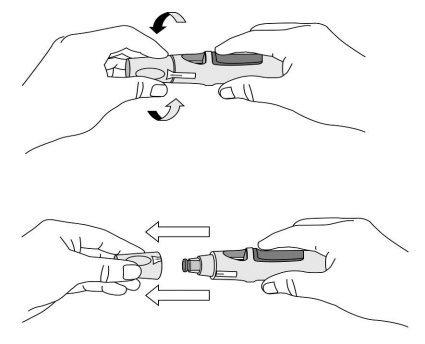
Рисунок 3
Нажмите предварительно заполненный инжектор на кожу (см. рисунки 4 и 5) без пинания кожи.
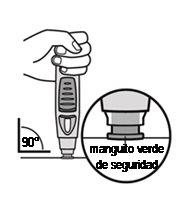
Рисунок 4
- Держите предварительно заполненный инжектор свободно одной рукой над синей кнопкой.
- Убедитесь, что зеленый защитный чехол стабилен и как можно более плоский против вашей кожи. Если предварительно заполненный инжектор не стабилен во время инъекции, существует риск повреждения иглы.
- НЕпинайте кожу, чтобы избежать случайных травм от укола иглы.
- НЕтрогайте и не нажимайте синюю кнопку, пока помещаете предварительно заполненный инжектор на кожу.
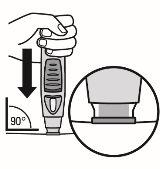
Рисунок 5
- Нажмите открытый конец предварительно заполненного инжектора на кожу под углом 90 градусов. Нажмите достаточно сильно, чтобы зеленый защитный чехол скользнул вверх и остался внутри прозрачного корпуса. Только самая широкая часть зеленого защитного чехла остается снаружи прозрачного корпуса.
- НЕнажимайте синюю кнопку, пока зеленый защитный чехол не скользнет внутрь прозрачного корпуса. Нажатие синей кнопки до того, как зеленый защитный чехол будет собран, может привести к неисправности инжектора.
- Вводите препарат без пинания кожи.
Нажмите кнопку инъекции (см. рисунки 6 и 7)
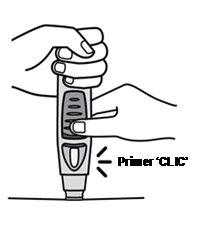
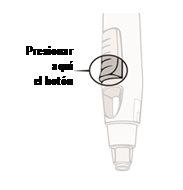
Рисунок 6 Рисунок 7
- Держите предварительно заполненный инжектор прижатым к коже.Чтобы начать инъекцию, используйте другую руку, чтобы нажать выступающую часть синей кнопки. Не нажимайте кнопку, если предварительно заполненный инжектор не прижат к коже и зеленый защитный чехол не скользит внутрь прозрачного корпуса.
- Как только кнопка нажата, она останется прижатой и не нужно продолжать нажимать ее.
- Если кажется, что нажатие кнопки затруднено, не нажимайте кнопку с большей силой. Отпустите кнопку, поднимите предварительно заполненный инжектор и начните заново. Убедитесь, что нет давления на кнопку, пока зеленый защитный чехол не будет полностью собран против кожи, затем нажмите выступающую часть синей кнопки.
- Вы услышите громкий звук, «щелчок»—не пугайтесь. Первый «щелчок» указывает на то, что игла была введена и началась инъекция. Вы можете не почувствовать укол в этот момент.
Не поднимайте предварительно заполненный инжектор с кожи. Если вы удалите предварительно заполненный инжектор с кожи, возможно, что не будет введена полная доза.
Продолжайте держать до второго «щелчка» (см. рисунок 8), это обычно занимает от 3 до 6 секунд, но может занять до 15 секунд, пока вы услышите второй «щелчок».
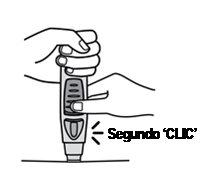
Рисунок 8
- Держите предварительно заполненный инжектор против кожи, пока не услышите второй «щелчок»(указывающий на то, что инъекция завершена и игла вернулась в предварительно заполненный инжектор).
- Поднимите предварительно заполненный инжектор с места инъекции.
- Примечание: Если вы не услышали второй «щелчок», подождите 15 секунд с момента первого нажатия кнопки, а затем поднимите автоинжектор с места инъекции.
- После инъекции
Используйте ватный шарик или марлю
- В месте инъекции может появиться небольшое количество крови или жидкости. Это нормально.
- С помощью ватного шарика или марли нажмите на место инъекции в течение 10 секунд.
- Если необходимо, закройте место инъекции небольшим повязкой.
- Не трите кожу.
Проверьте окно—желтый индикатор подтверждает правильное введение (см. рисунок 9)
- Желтый индикатор связан с поршнем предварительно заполненного инжектора. Если желтый индикатор не виден в окне, поршень не переместился правильно, и инъекция не произошла.
- Желтый индикатор заполнит почти половину окна. Это нормально.
- Если желтый индикатор не появляется в окне или если вы подозреваете, что возможно, не получили полную дозу, обратитесь к врачу или фармацевту. Не вводите вторую дозу без консультации с врачом.
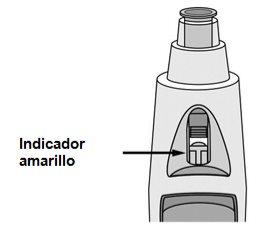
Рисунок 9
Утилизируйте предварительно заполненный инжектор (см. рисунок 10)
- Затем поместите инжектор в контейнер для острых предметов. Следуйте инструкциям врача или медсестры по утилизации контейнера, когда он будет заполнен.
Если вы считаете, что что-то пошло не так во время инъекции или у вас есть какие-либо сомнения, обратитесь к врачу или фармацевту.
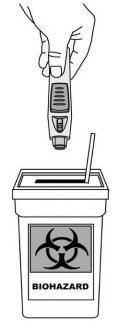
Рисунок 10
- Страна регистрации
- Активное вещество
- Требуется рецептДа
- Производитель
- Информация носит справочный характер и не является медицинской рекомендацией. Перед приемом любых препаратов проконсультируйтесь с врачом. Oladoctor не несет ответственности за медицинские решения, принятые на основе этого контента.
- Аналоги СИМПОНИ 100 мг РАСТВОР ДЛЯ ИНЪЕКЦИЙ В ПРЕДНАПОЛНЕННОМ ШПРИЦЕ-РУЧКЕФорма выпуска: ИНЪЕКЦИОННЫЙ РАСТВОР, 50 мгАктивное вещество: ГолимумабПроизводитель: Janssen Biologics B.V.Требуется рецептФорма выпуска: ИНЪЕКЦИОННЫЙ РАСТВОР, 20 мгАктивное вещество: АдалимумабПроизводитель: Amgen Europe B.V.Требуется рецептФорма выпуска: ИНЪЕКЦИОННЫЙ РАСТВОР, 20 мгАктивное вещество: АдалимумабПроизводитель: Amgen Europe B.V.Требуется рецепт
Аналоги СИМПОНИ 100 мг РАСТВОР ДЛЯ ИНЪЕКЦИЙ В ПРЕДНАПОЛНЕННОМ ШПРИЦЕ-РУЧКЕ в других странах
Лучшие аналоги с тем же действующим веществом и терапевтическим эффектом.
Аналог СИМПОНИ 100 мг РАСТВОР ДЛЯ ИНЪЕКЦИЙ В ПРЕДНАПОЛНЕННОМ ШПРИЦЕ-РУЧКЕ в Україна
Врачи онлайн по СИМПОНИ 100 мг РАСТВОР ДЛЯ ИНЪЕКЦИЙ В ПРЕДНАПОЛНЕННОМ ШПРИЦЕ-РУЧКЕ
Консультация по дозировке, побочным эффектам, взаимодействиям, противопоказаниям и продлению рецепта на СИМПОНИ 100 мг РАСТВОР ДЛЯ ИНЪЕКЦИЙ В ПРЕДНАПОЛНЕННОМ ШПРИЦЕ-РУЧКЕ – по решению врача и с учетом местных правил.





